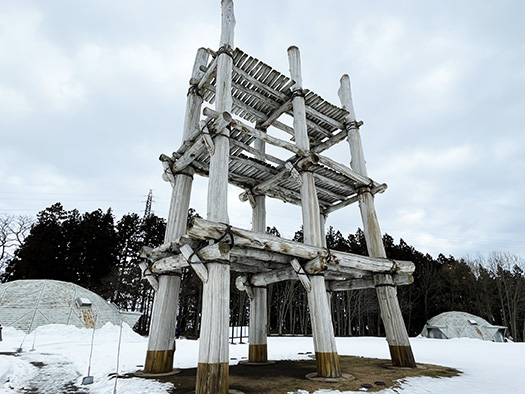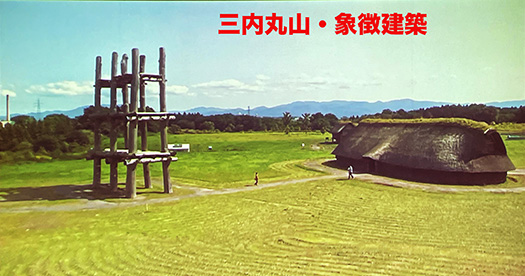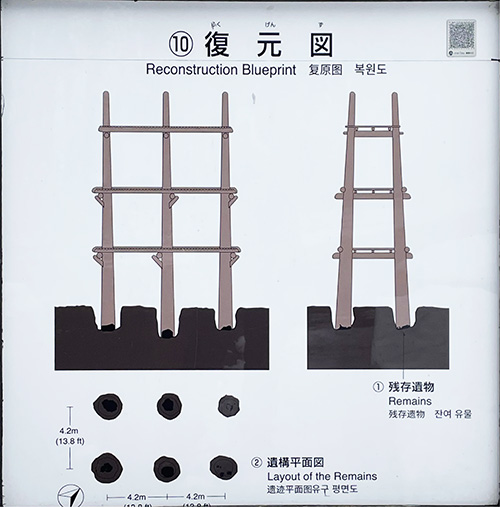


人類と集住的共同体「ムラ」的生き方について考えて見ています。人口減少局面でこれまでのような新築住宅建設にどっぷり依存した住宅産業構造から、どうすれば既存建築の高度化需要を考えていけるのかと問題を立てれば、人間のシアワセの根源要素を見返す必要がある。
簡単に言って住宅リフォームの需要促進にはなにが必要かと考えれば、人間は「限界集落化」していくような街区に対してよりも「よき住宅地」に対して投資的になれるだろうという判断。
たとえば現状のなかで性能向上型リフォームに対して60代前後の世代は、いったいどうすれば動機を持てるのかというテーマ。ひとつ考えられるとすれば「よき住宅地」にある資産としての住宅を、子や孫世代のためにと考えさらに価値向上させたいという資産継承的需要。
もしくは30-40代の若年層が、既存の「よき住宅地」にある比較的安価な中古住宅を購入してその住宅を性能向上させてよき人生を獲得したいと考える需要。
このふたつの需要動機が考えられるけれど、どちらにしても人口減少局面ではより大きく「住宅地」の価値感に注目が集まるのではないかという直感であります。その「良き住宅地」判断の目安にはいったいどういう基準があるか。人間居住環境としての「ムラ」的魅力を探究したいのです。
そういったテーマ意識から昨日は世界最古の集住「ムラ」環境について調べてみた次第。そこで石造の「塔」建築が地域の「ランドマーク」であった事実を知った。しかもエジプトにピラミッドが建設されるまで世界最高の高さの建築だったという。人間意識にとってこういう象徴的建築には、ムラ的愛着を刺激するなにか根源的要素があるのかもしれないと。
そうした流れから、三内丸山の列島最古の「大型掘立柱建物」が強く脳裏に再生されてきた。
これは大型掘立柱建物跡をもとに高さ14.7mの建物として復元されたもの。建築用途としては神殿、物見やぐら、モニュメントなどの説が唱えられている。復元図を参照すれば遺っていた基底部の木片の大きさ・掛かっていた土圧の分析結果などから推定された。しかもこれら柱穴は4.2m間隔で規則的に配置されている。
やはり目的的建築、ムラの統合性を表現したランドマークだったことが想像できる。単純に高層建築として、その建物が「見える空間範囲」というテリトリー意識にはわかりやすい普遍性を感じる。
縄文というのは基本は採集と狩猟が生業だけれど、日本列島では海浜での漁労という非常に「豊かな」食糧確保手段が確立されていた社会。狩猟が獲物としての陸上動物の季節移動に随伴して移動する暮らしようだったのに対して、定住性がきわめて高かった。
どうもわたしには、この三内丸山が列島社会の「八百万」のムラ社会、自然な地域共同体の始原的姿なのではないかと思えてならないのです。
English version⬇
5-6,000 years ago “Jomon landmarks” Mura and livability-8
Survival as a group has been a natural state of human beings since the beginning. Ease of living and livability are probably the greatest factors that attract humans. …
We have been thinking and looking at the human race and the “mura” way of living, a community of people living together. If we ask ourselves how we can shift from a housing industry structure that relies heavily on new housing construction to one that considers the demand for upgrading existing buildings, we need to look back at the root elements of human sheer willpower.
Simply put, what is needed to promote demand for home renovation?
For example, how can we motivate people in their 60s to renovate their homes to improve performance? One possibility is that they would like to improve the value of their homes as assets in “good residential areas” for their children and grandchildren, as if they were inheriting the assets.
Or, young people in their 30s and 40s who purchase relatively inexpensive existing houses in “good residential areas” and wish to improve the performance of their houses to lead a better life.
In either case, my intuition is that the declining population will focus more attention on the value of “residential areas. What criteria should be used to determine what constitutes a “good residential area”? I would like to explore the attractiveness of “mura” as an environment for human habitation.
With this in mind, I spent yesterday researching the world’s oldest residential “mura” environment. There, I learned that stone “towers” were local “landmarks. Moreover, they were the tallest structures in the world until the construction of the pyramids in Egypt. I thought that such symbolic architecture might have some fundamental element in human consciousness that stimulates mura-like attachment.
This process brought to mind the oldest “large hottate-bashira” building in the archipelago at Sannai-Maruyama, which is the site of a large hottate-bashira building.
This is a 14.7-meter-high building reconstructed from the ruins of a large hottate-bashira building. Some people have suggested that it was used as a temple, a watchtower, or a monument. The size of the wood chips at the base and the results of the analysis of the soil pressure on the building were estimated by referring to the restored drawings. Moreover, these post holes are regularly spaced at 4.2m intervals.
It can be imagined that this was a landmark expressing the purpose of architecture and the integrity of the mura (village). As a simple high-rise structure, the building’s territorial awareness of the “visible range of space” has a sense of universality that is easy to understand.
The Jomon were a society whose basic livelihood consisted of gathering and hunting, but in the Japanese archipelago they had established a very “rich” means of securing food by fishing on the seashore. While hunting was a way of life that moved along with the seasonal migration of land animals as prey, the society was highly sedentary.
I can’t help but think that Sannai-Maruyama is the primitive form of the “eight million” village society of archipelagic society, a natural regional community.
Posted on 2月 21st, 2024 by 三木 奎吾
Filed under: 住宅マーケティング







コメントを投稿
「※誹謗中傷や、悪意のある書き込み、営利目的などのコメントを防ぐために、投稿された全てのコメントは一時的に保留されますのでご了承ください。」
You must be logged in to post a comment.